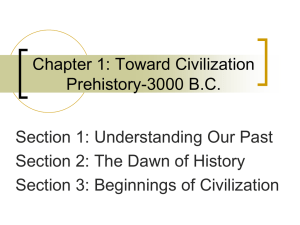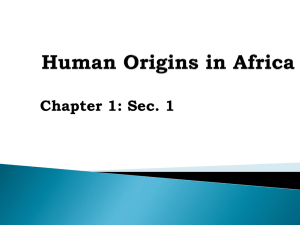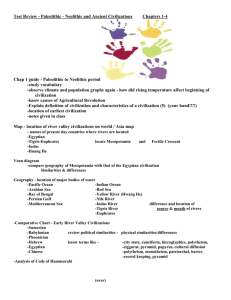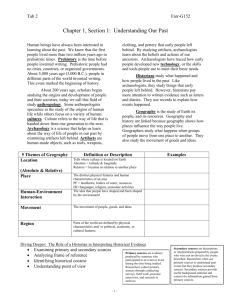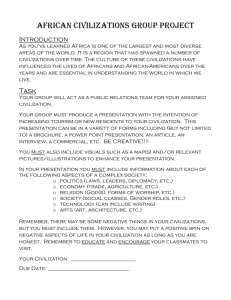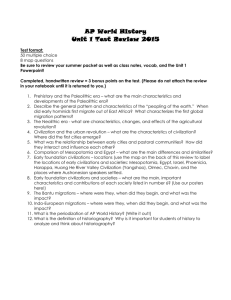Chapter 1: Toward Civilization
advertisement
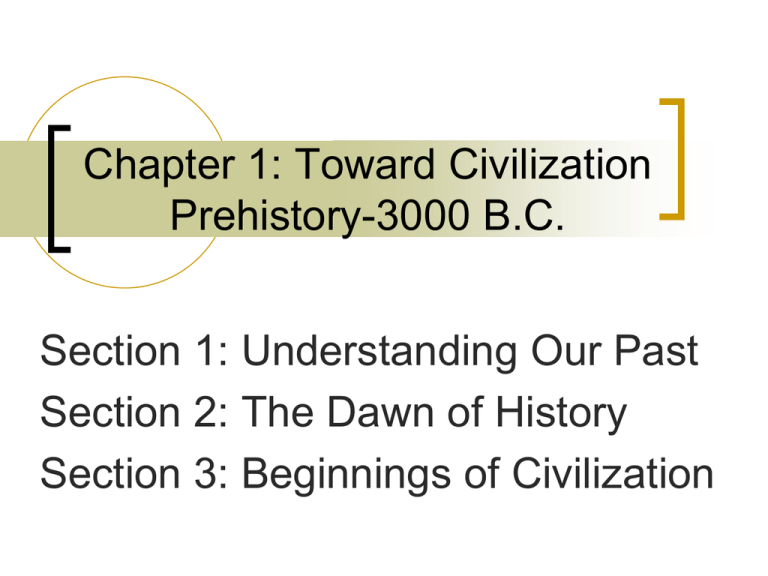
Chapter 1: Toward Civilization Prehistory-3000 B.C. Section 1: Understanding Our Past Section 2: The Dawn of History Section 3: Beginnings of Civilization Section 1: Understanding Our Past Summary: Scientists and historians study the past to see how early people lived Section 1: Understanding Our Past Human beings have always been interested about learning about the past We know the first people lived more than 2 million years ago in prehistoric times Section 1: Understanding Our Past Prehistory is the time before people invented writing Section 1: Understanding Our Past Prehistoric peoples had no cities, countries, or organized governments About 5,000 year’s ago, some people in different parts of the world invented writing This event marked the beginning of human history Section 1: Understanding Our Past Archaeology is a science that helps us learn about the past It is a study of how early people lived Section 1: Understanding Our Past Archaeologists are scientists that study artifacts Artifacts are things such as tools, weapons, or clothing, that early people left behind Section 1: Understanding Our Past By studying artifacts, archaeologists learn about the beliefs and actions of our ancestors Section 1: Understanding Our Past Historians also study how people lived in the past Like archaeologists, they study things that early people left behind Section 1: Understanding Our Past However, historians pay more attention to written artifacts such as letters and diaries They use records to explain how events happened Section 1: Understanding Our Past Geography is the study of earth and its people Geography and history are linked because geography shows how places influence the way people live Section 1: Understanding Our Past Geographers study what happens when groups of people move from one place to another They also study the movement of goods and ideas Section 1: Understanding Our Past Archaeology History Geography What is it? Study of early people by examining the things they left behind Study of what Study of Earth, people, & happened and how resources people lived in the past Who does it? Archaeologist Historian Geographer Study artifacts, especially written documents Study where people lived and why they lived there What do Study of artifacts, they such as tools, do? weapons, clothing, pottery Why do they do it? To learn about the To learn how beliefs and activities events happened of a group of people To learn how places affect the way people live and how people move from place to place Section 2: The Dawn of History Summary: Old Stone Age (Paleolithic) people made tools and learned skills to survive The New Stone Age (Neolithic) brought farming and settled communities Section 2: The Dawn of History The earliest people lived during the Old Stone Age This period is also called the Paleolithic Age The Old Stone Age began more than 2 million years ago Section 2: The Dawn of History Paleolithic people were Nomads Nomads moved from place to place, hunting and gathering food They made simple tools and weapons from stone, bone, or wood As time passed, they developed a spoken language Section 2: The Dawn of History Paleolithic people developed religious beliefs They thought the world was filled with spirits They also believed in life after death Section 2: The Dawn of History Old Stone Age people buried tools and weapons with their dead so that they had what they needed in the afterlife Section 2: The Dawn of History Around 10,000 B.C., people made two very important discoveries 1.) They learned to plant seeds to grow food 2.) They learned to tame (domesticate) animals These discoveries allowed people to stay in one place and farm Section 2: The Dawn of History This change marked the beginning of the New Stone Age, or the Neolithic Age Section 2: The Dawn of History Historians call these discoveries the Neolithic Agricultural Revolution because they changed the way people lived Section 2: The Dawn of History After the Neolithic Agricultural Revolution, there was more food to eat With more food the population increased Section 2: The Dawn of History People lived together in villages These villages later led to the development of advanced societies called Civilizations Section 2: The Dawn of History 1st spoken languages Very small population Nomads Old Stone Age Discovery of fire (Paleolithic Age) 2,500,000 B.C. Hunter and gatherers Simple tools and weapons Cave paintings Belief in afterlife Section 2: The Dawn of History Increasing population Villages Calendar & technology New Stone Age Personal possessions (Neolithic Age) 10,000 B.C. Farmers Domestic animals Village headman Council of elders Section 3: Beginnings of Civilization Summary: Civilizations share basic features Contacts between civilizations brought cultural change Section 3: Beginnings of Civilization By about 5,000 years ago, the first civilizations began to develop Historians have found basic features common to most early civilizations: Cities Organized Governments Social Classes Section 3: Beginnings of Civilization The most important feature of early civilizations was the rise of cities The first cities developed as people began to farm along river valleys in the Middle East, Africa, and Asia Section 3: Beginnings of Civilization These river valleys provided: Water Fertile (rich) soil Transportation Section 3: Beginnings of Civilization Farmers living in river valleys could produce extra food More food helped the population to grow As a result villages slowly grew into cities Section 3: Beginnings of Civilization All civilizations change as time passes Civilizations change when the environment changes [For example, when all wood in a forest has been cut, people must find new building materials] Section 3: Beginnings of Civilization Civilizations also change through Cultural Diffusion Cultural Diffusion is the sharing of ideas and technology Cultural Diffusion results from war, trade, and the migration of people Section 3: Beginnings of Civilization Organized Religion Central Government Job Specialization System of writing Social Classes What is a civilization? Roads, bridges, temples, etc Art & Architecture Cities
![world history - New Page 1 [je074.k12.sd.us]](http://s2.studylib.net/store/data/009977422_1-26b439736c031db692fcb89a191e6c98-300x300.png)

